Evidence-Based Practice Assessment Workbook: Analysis and Evaluation
VerifiedAdded on 2022/12/15
|13
|2406
|479
Homework Assignment
AI Summary
This assignment provides a comprehensive analysis of an evidence-based practice (EBP) assessment workbook, focusing on the impact of pacifier use on breastfeeding. The assessment addresses key questions related to EBP, including its definition, importance, and application in healthcare settings. The analysis evaluates research methodologies, participant identification, intervention descriptions, and randomization processes. The study explores observational studies versus randomized controlled trials (RCTs) in relation to pacifier use and breastfeeding duration. It examines the identification of study groups, questionnaire validation, and the importance of equal care among groups. The assignment also evaluates power calculations, intervention effects, outcome measurements, and potential sources of bias. Statistical tests, p-values, and the benefits versus harms of interventions are also assessed, along with the examination of the reference list for any potential bias.
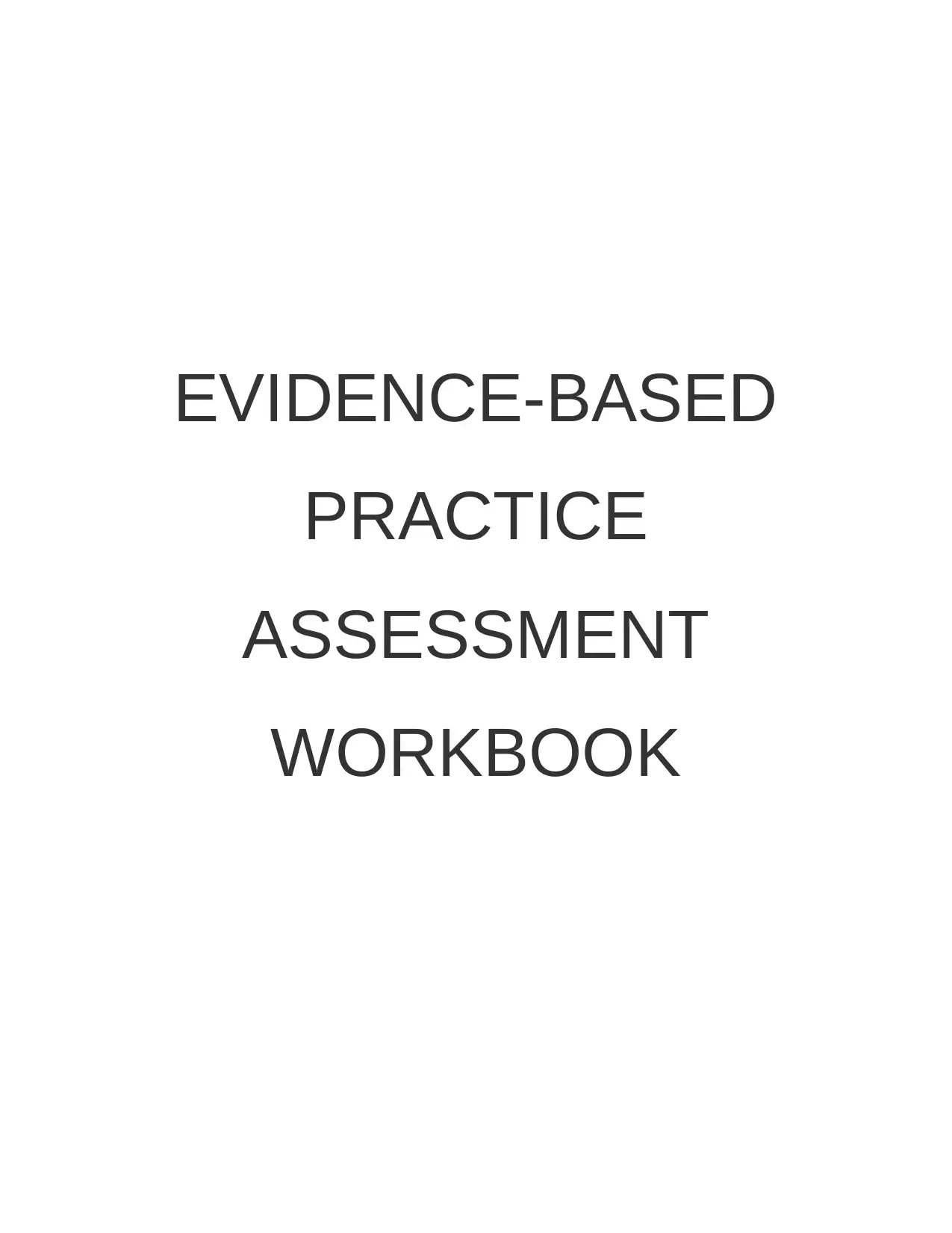
EVIDENCE-BASED
PRACTICE
ASSESSMENT
WORKBOOK
PRACTICE
ASSESSMENT
WORKBOOK
Paraphrase This Document
Need a fresh take? Get an instant paraphrase of this document with our AI Paraphraser
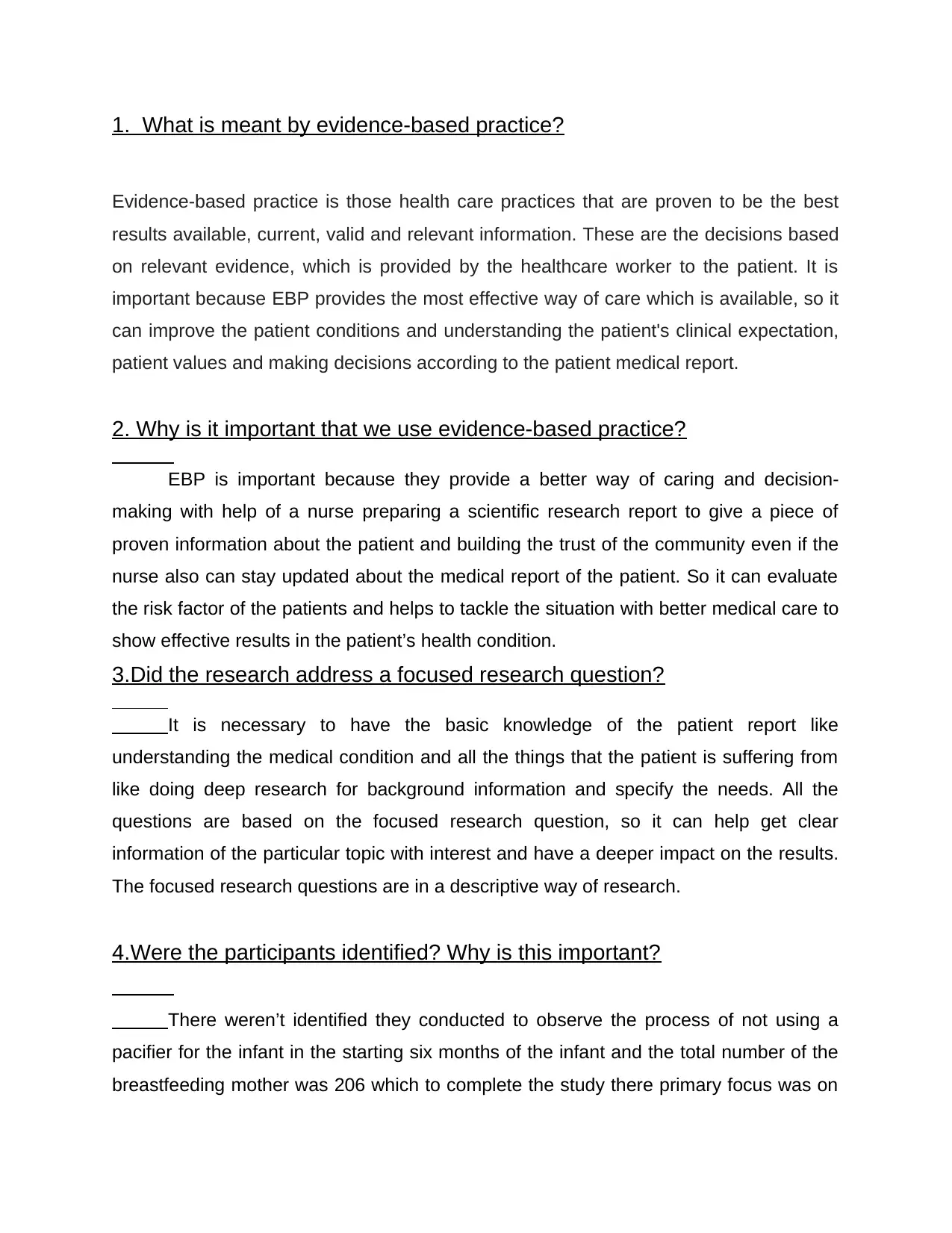
1. What is meant by evidence-based practice?
Evidence-based practice is those health care practices that are proven to be the best
results available, current, valid and relevant information. These are the decisions based
on relevant evidence, which is provided by the healthcare worker to the patient. It is
important because EBP provides the most effective way of care which is available, so it
can improve the patient conditions and understanding the patient's clinical expectation,
patient values and making decisions according to the patient medical report.
2. Why is it important that we use evidence-based practice?
EBP is important because they provide a better way of caring and decision-
making with help of a nurse preparing a scientific research report to give a piece of
proven information about the patient and building the trust of the community even if the
nurse also can stay updated about the medical report of the patient. So it can evaluate
the risk factor of the patients and helps to tackle the situation with better medical care to
show effective results in the patient’s health condition.
3.Did the research address a focused research question?
It is necessary to have the basic knowledge of the patient report like
understanding the medical condition and all the things that the patient is suffering from
like doing deep research for background information and specify the needs. All the
questions are based on the focused research question, so it can help get clear
information of the particular topic with interest and have a deeper impact on the results.
The focused research questions are in a descriptive way of research.
4.Were the participants identified? Why is this important?
There weren’t identified they conducted to observe the process of not using a
pacifier for the infant in the starting six months of the infant and the total number of the
breastfeeding mother was 206 which to complete the study there primary focus was on
Evidence-based practice is those health care practices that are proven to be the best
results available, current, valid and relevant information. These are the decisions based
on relevant evidence, which is provided by the healthcare worker to the patient. It is
important because EBP provides the most effective way of care which is available, so it
can improve the patient conditions and understanding the patient's clinical expectation,
patient values and making decisions according to the patient medical report.
2. Why is it important that we use evidence-based practice?
EBP is important because they provide a better way of caring and decision-
making with help of a nurse preparing a scientific research report to give a piece of
proven information about the patient and building the trust of the community even if the
nurse also can stay updated about the medical report of the patient. So it can evaluate
the risk factor of the patients and helps to tackle the situation with better medical care to
show effective results in the patient’s health condition.
3.Did the research address a focused research question?
It is necessary to have the basic knowledge of the patient report like
understanding the medical condition and all the things that the patient is suffering from
like doing deep research for background information and specify the needs. All the
questions are based on the focused research question, so it can help get clear
information of the particular topic with interest and have a deeper impact on the results.
The focused research questions are in a descriptive way of research.
4.Were the participants identified? Why is this important?
There weren’t identified they conducted to observe the process of not using a
pacifier for the infant in the starting six months of the infant and the total number of the
breastfeeding mother was 206 which to complete the study there primary focus was on
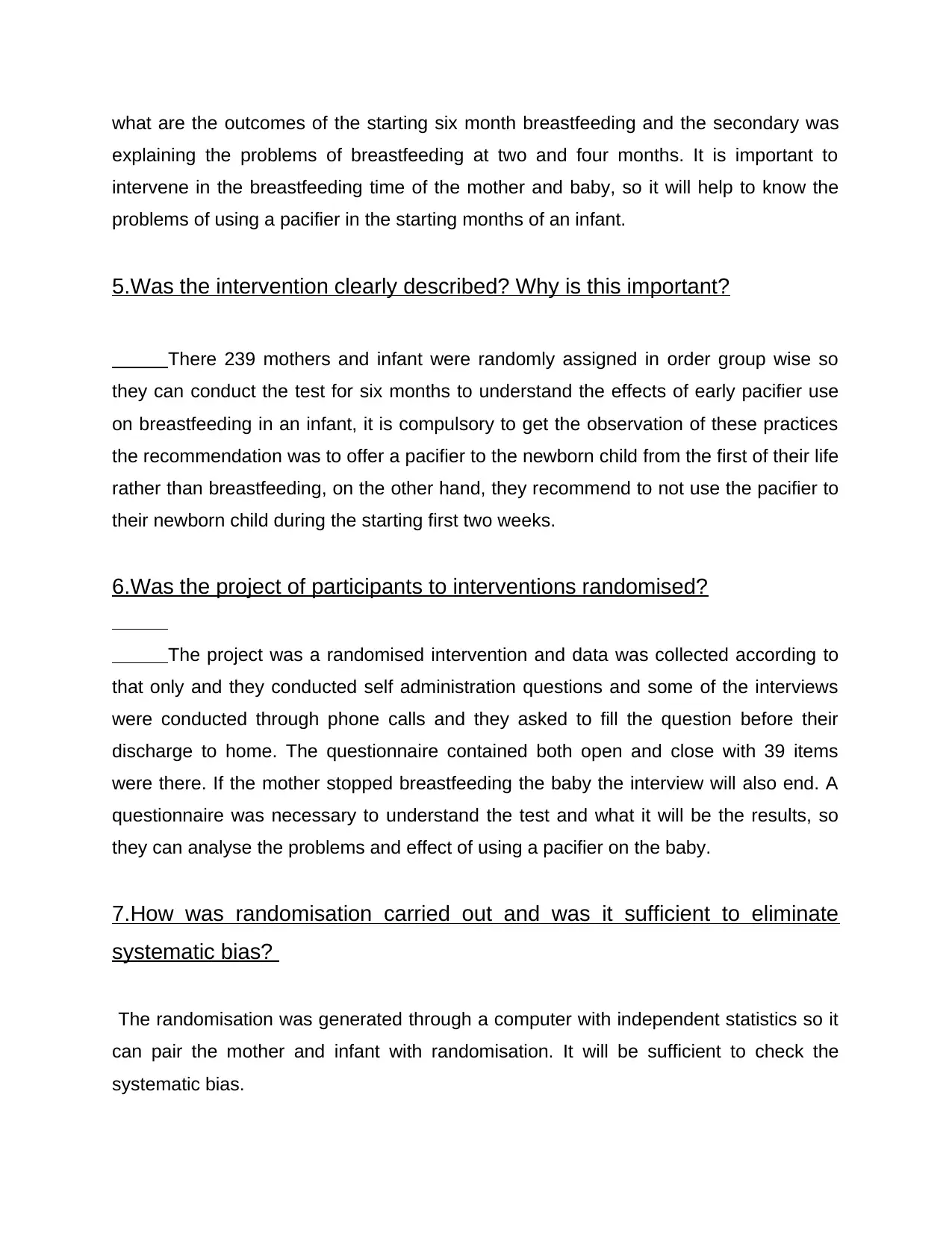
what are the outcomes of the starting six month breastfeeding and the secondary was
explaining the problems of breastfeeding at two and four months. It is important to
intervene in the breastfeeding time of the mother and baby, so it will help to know the
problems of using a pacifier in the starting months of an infant.
5.Was the intervention clearly described? Why is this important?
There 239 mothers and infant were randomly assigned in order group wise so
they can conduct the test for six months to understand the effects of early pacifier use
on breastfeeding in an infant, it is compulsory to get the observation of these practices
the recommendation was to offer a pacifier to the newborn child from the first of their life
rather than breastfeeding, on the other hand, they recommend to not use the pacifier to
their newborn child during the starting first two weeks.
6.Was the project of participants to interventions randomised?
The project was a randomised intervention and data was collected according to
that only and they conducted self administration questions and some of the interviews
were conducted through phone calls and they asked to fill the question before their
discharge to home. The questionnaire contained both open and close with 39 items
were there. If the mother stopped breastfeeding the baby the interview will also end. A
questionnaire was necessary to understand the test and what it will be the results, so
they can analyse the problems and effect of using a pacifier on the baby.
7.How was randomisation carried out and was it sufficient to eliminate
systematic bias?
The randomisation was generated through a computer with independent statistics so it
can pair the mother and infant with randomisation. It will be sufficient to check the
systematic bias.
explaining the problems of breastfeeding at two and four months. It is important to
intervene in the breastfeeding time of the mother and baby, so it will help to know the
problems of using a pacifier in the starting months of an infant.
5.Was the intervention clearly described? Why is this important?
There 239 mothers and infant were randomly assigned in order group wise so
they can conduct the test for six months to understand the effects of early pacifier use
on breastfeeding in an infant, it is compulsory to get the observation of these practices
the recommendation was to offer a pacifier to the newborn child from the first of their life
rather than breastfeeding, on the other hand, they recommend to not use the pacifier to
their newborn child during the starting first two weeks.
6.Was the project of participants to interventions randomised?
The project was a randomised intervention and data was collected according to
that only and they conducted self administration questions and some of the interviews
were conducted through phone calls and they asked to fill the question before their
discharge to home. The questionnaire contained both open and close with 39 items
were there. If the mother stopped breastfeeding the baby the interview will also end. A
questionnaire was necessary to understand the test and what it will be the results, so
they can analyse the problems and effect of using a pacifier on the baby.
7.How was randomisation carried out and was it sufficient to eliminate
systematic bias?
The randomisation was generated through a computer with independent statistics so it
can pair the mother and infant with randomisation. It will be sufficient to check the
systematic bias.
⊘ This is a preview!⊘
Do you want full access?
Subscribe today to unlock all pages.

Trusted by 1+ million students worldwide
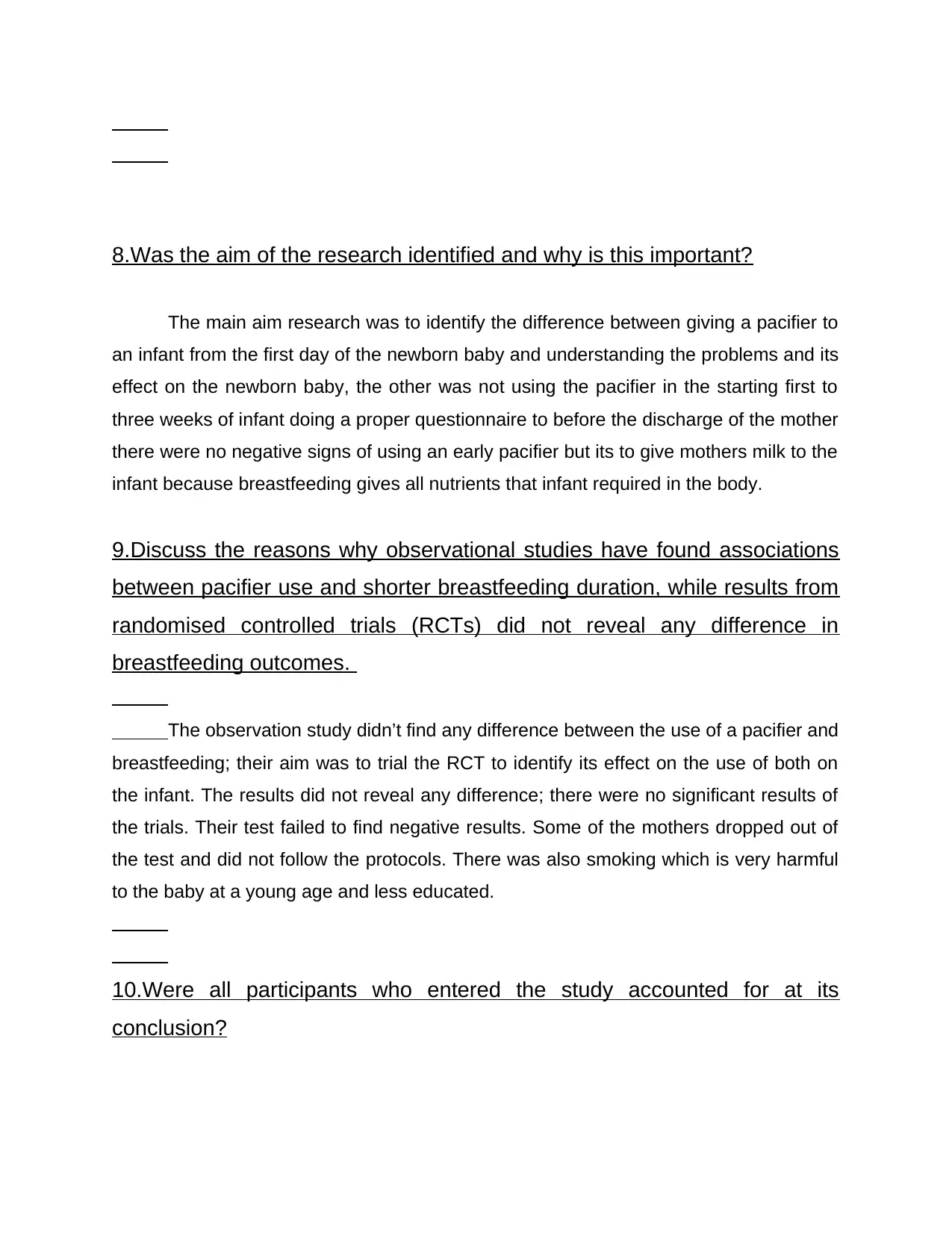
8.Was the aim of the research identified and why is this important?
The main aim research was to identify the difference between giving a pacifier to
an infant from the first day of the newborn baby and understanding the problems and its
effect on the newborn baby, the other was not using the pacifier in the starting first to
three weeks of infant doing a proper questionnaire to before the discharge of the mother
there were no negative signs of using an early pacifier but its to give mothers milk to the
infant because breastfeeding gives all nutrients that infant required in the body.
9.Discuss the reasons why observational studies have found associations
between pacifier use and shorter breastfeeding duration, while results from
randomised controlled trials (RCTs) did not reveal any difference in
breastfeeding outcomes.
The observation study didn’t find any difference between the use of a pacifier and
breastfeeding; their aim was to trial the RCT to identify its effect on the use of both on
the infant. The results did not reveal any difference; there were no significant results of
the trials. Their test failed to find negative results. Some of the mothers dropped out of
the test and did not follow the protocols. There was also smoking which is very harmful
to the baby at a young age and less educated.
10.Were all participants who entered the study accounted for at its
conclusion?
The main aim research was to identify the difference between giving a pacifier to
an infant from the first day of the newborn baby and understanding the problems and its
effect on the newborn baby, the other was not using the pacifier in the starting first to
three weeks of infant doing a proper questionnaire to before the discharge of the mother
there were no negative signs of using an early pacifier but its to give mothers milk to the
infant because breastfeeding gives all nutrients that infant required in the body.
9.Discuss the reasons why observational studies have found associations
between pacifier use and shorter breastfeeding duration, while results from
randomised controlled trials (RCTs) did not reveal any difference in
breastfeeding outcomes.
The observation study didn’t find any difference between the use of a pacifier and
breastfeeding; their aim was to trial the RCT to identify its effect on the use of both on
the infant. The results did not reveal any difference; there were no significant results of
the trials. Their test failed to find negative results. Some of the mothers dropped out of
the test and did not follow the protocols. There was also smoking which is very harmful
to the baby at a young age and less educated.
10.Were all participants who entered the study accounted for at its
conclusion?
Paraphrase This Document
Need a fresh take? Get an instant paraphrase of this document with our AI Paraphraser
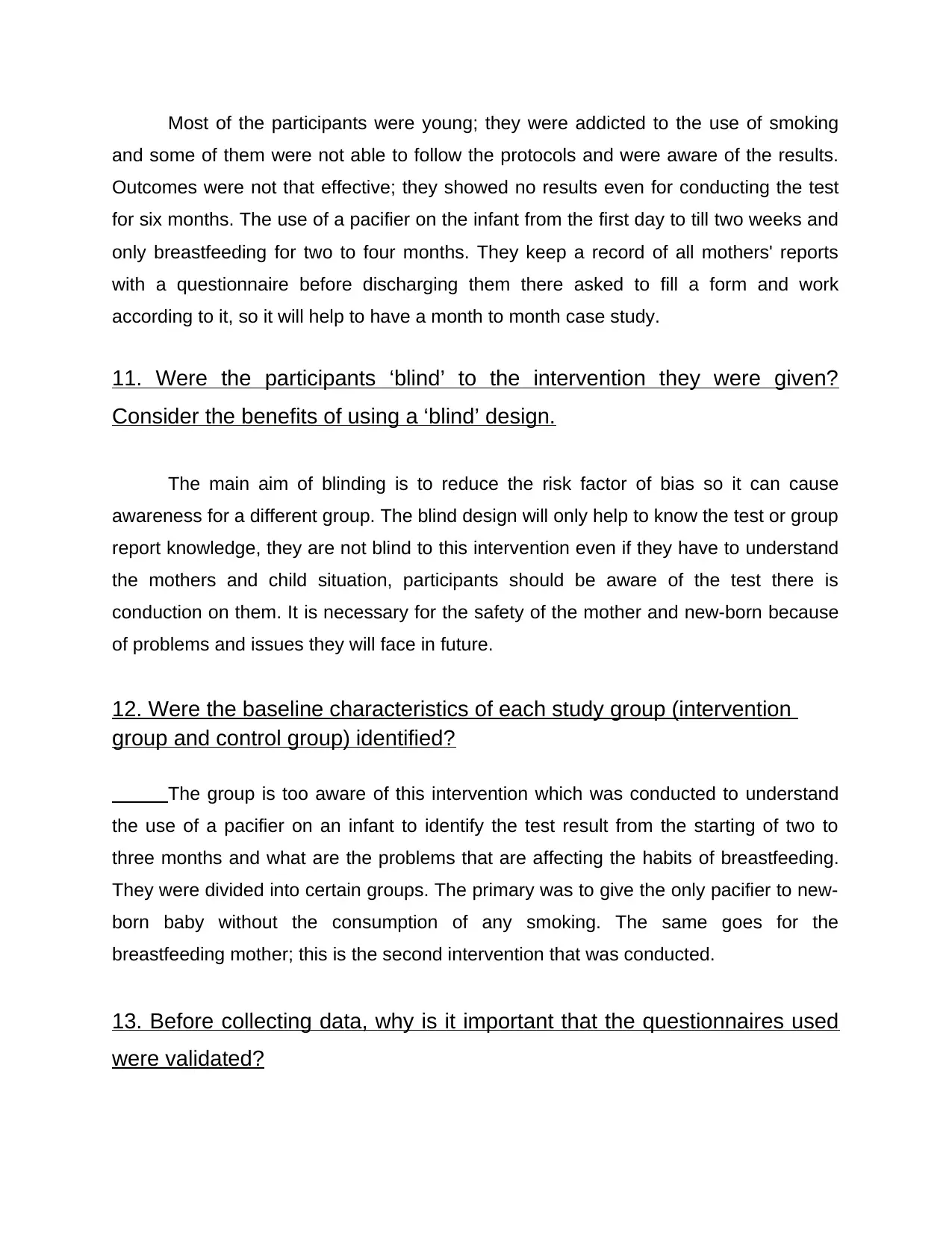
Most of the participants were young; they were addicted to the use of smoking
and some of them were not able to follow the protocols and were aware of the results.
Outcomes were not that effective; they showed no results even for conducting the test
for six months. The use of a pacifier on the infant from the first day to till two weeks and
only breastfeeding for two to four months. They keep a record of all mothers' reports
with a questionnaire before discharging them there asked to fill a form and work
according to it, so it will help to have a month to month case study.
11. Were the participants ‘blind’ to the intervention they were given?
Consider the benefits of using a ‘blind’ design.
The main aim of blinding is to reduce the risk factor of bias so it can cause
awareness for a different group. The blind design will only help to know the test or group
report knowledge, they are not blind to this intervention even if they have to understand
the mothers and child situation, participants should be aware of the test there is
conduction on them. It is necessary for the safety of the mother and new-born because
of problems and issues they will face in future.
12. Were the baseline characteristics of each study group (intervention
group and control group) identified?
The group is too aware of this intervention which was conducted to understand
the use of a pacifier on an infant to identify the test result from the starting of two to
three months and what are the problems that are affecting the habits of breastfeeding.
They were divided into certain groups. The primary was to give the only pacifier to new-
born baby without the consumption of any smoking. The same goes for the
breastfeeding mother; this is the second intervention that was conducted.
13. Before collecting data, why is it important that the questionnaires used
were validated?
and some of them were not able to follow the protocols and were aware of the results.
Outcomes were not that effective; they showed no results even for conducting the test
for six months. The use of a pacifier on the infant from the first day to till two weeks and
only breastfeeding for two to four months. They keep a record of all mothers' reports
with a questionnaire before discharging them there asked to fill a form and work
according to it, so it will help to have a month to month case study.
11. Were the participants ‘blind’ to the intervention they were given?
Consider the benefits of using a ‘blind’ design.
The main aim of blinding is to reduce the risk factor of bias so it can cause
awareness for a different group. The blind design will only help to know the test or group
report knowledge, they are not blind to this intervention even if they have to understand
the mothers and child situation, participants should be aware of the test there is
conduction on them. It is necessary for the safety of the mother and new-born because
of problems and issues they will face in future.
12. Were the baseline characteristics of each study group (intervention
group and control group) identified?
The group is too aware of this intervention which was conducted to understand
the use of a pacifier on an infant to identify the test result from the starting of two to
three months and what are the problems that are affecting the habits of breastfeeding.
They were divided into certain groups. The primary was to give the only pacifier to new-
born baby without the consumption of any smoking. The same goes for the
breastfeeding mother; this is the second intervention that was conducted.
13. Before collecting data, why is it important that the questionnaires used
were validated?
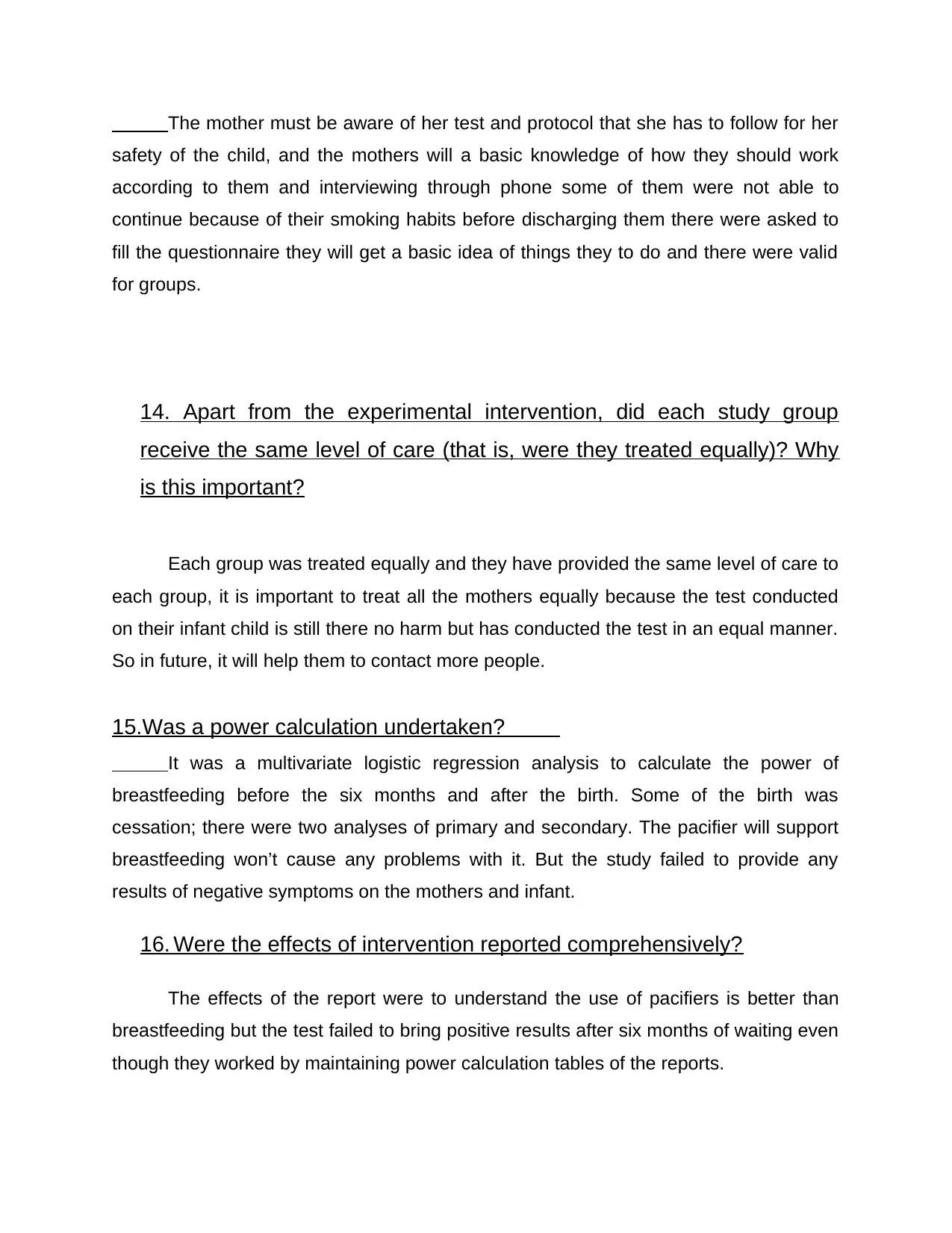
The mother must be aware of her test and protocol that she has to follow for her
safety of the child, and the mothers will a basic knowledge of how they should work
according to them and interviewing through phone some of them were not able to
continue because of their smoking habits before discharging them there were asked to
fill the questionnaire they will get a basic idea of things they to do and there were valid
for groups.
14. Apart from the experimental intervention, did each study group
receive the same level of care (that is, were they treated equally)? Why
is this important?
Each group was treated equally and they have provided the same level of care to
each group, it is important to treat all the mothers equally because the test conducted
on their infant child is still there no harm but has conducted the test in an equal manner.
So in future, it will help them to contact more people.
15.Was a power calculation undertaken?
It was a multivariate logistic regression analysis to calculate the power of
breastfeeding before the six months and after the birth. Some of the birth was
cessation; there were two analyses of primary and secondary. The pacifier will support
breastfeeding won’t cause any problems with it. But the study failed to provide any
results of negative symptoms on the mothers and infant.
16. Were the effects of intervention reported comprehensively?
The effects of the report were to understand the use of pacifiers is better than
breastfeeding but the test failed to bring positive results after six months of waiting even
though they worked by maintaining power calculation tables of the reports.
safety of the child, and the mothers will a basic knowledge of how they should work
according to them and interviewing through phone some of them were not able to
continue because of their smoking habits before discharging them there were asked to
fill the questionnaire they will get a basic idea of things they to do and there were valid
for groups.
14. Apart from the experimental intervention, did each study group
receive the same level of care (that is, were they treated equally)? Why
is this important?
Each group was treated equally and they have provided the same level of care to
each group, it is important to treat all the mothers equally because the test conducted
on their infant child is still there no harm but has conducted the test in an equal manner.
So in future, it will help them to contact more people.
15.Was a power calculation undertaken?
It was a multivariate logistic regression analysis to calculate the power of
breastfeeding before the six months and after the birth. Some of the birth was
cessation; there were two analyses of primary and secondary. The pacifier will support
breastfeeding won’t cause any problems with it. But the study failed to provide any
results of negative symptoms on the mothers and infant.
16. Were the effects of intervention reported comprehensively?
The effects of the report were to understand the use of pacifiers is better than
breastfeeding but the test failed to bring positive results after six months of waiting even
though they worked by maintaining power calculation tables of the reports.
⊘ This is a preview!⊘
Do you want full access?
Subscribe today to unlock all pages.

Trusted by 1+ million students worldwide
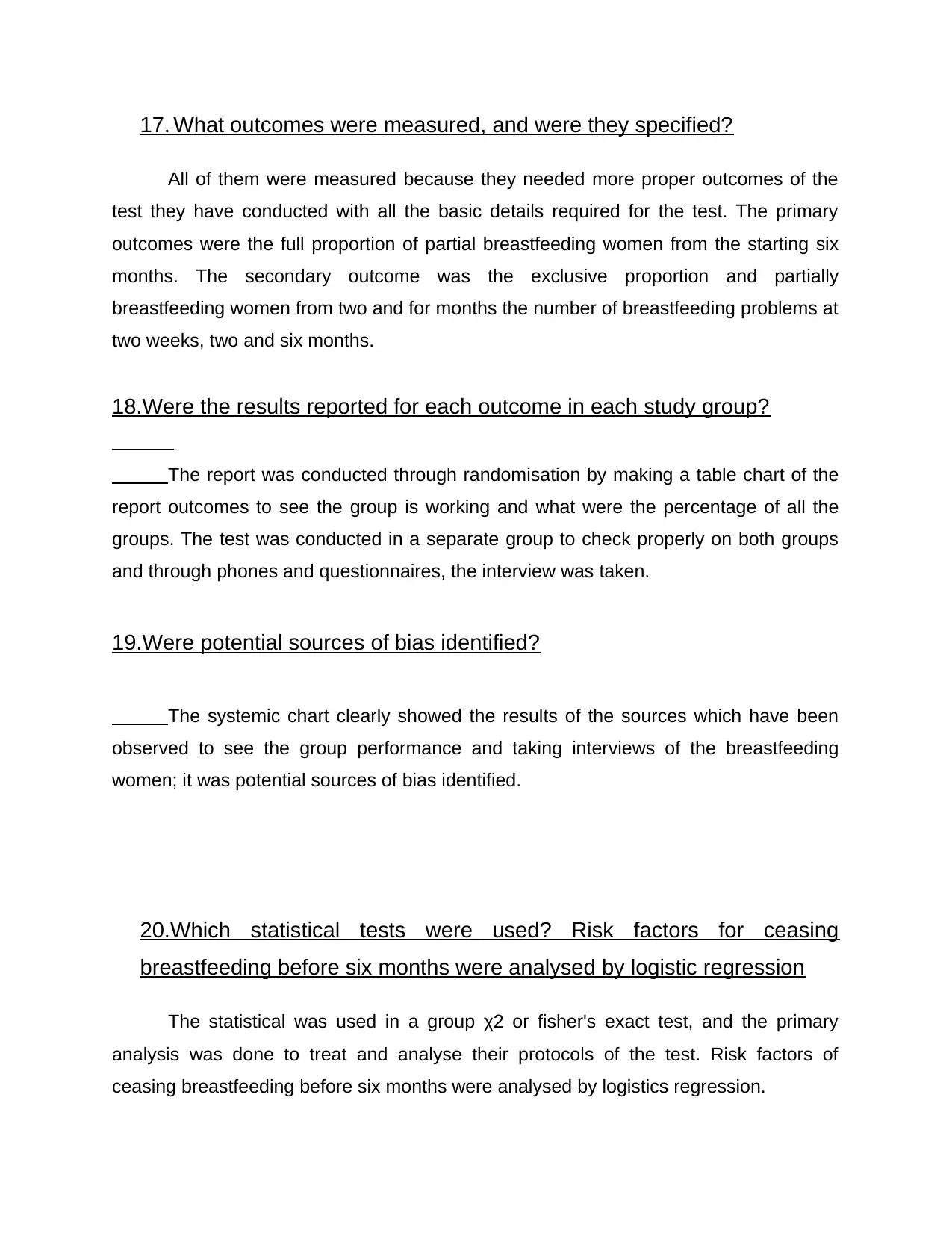
17. What outcomes were measured, and were they specified?
All of them were measured because they needed more proper outcomes of the
test they have conducted with all the basic details required for the test. The primary
outcomes were the full proportion of partial breastfeeding women from the starting six
months. The secondary outcome was the exclusive proportion and partially
breastfeeding women from two and for months the number of breastfeeding problems at
two weeks, two and six months.
18.Were the results reported for each outcome in each study group?
The report was conducted through randomisation by making a table chart of the
report outcomes to see the group is working and what were the percentage of all the
groups. The test was conducted in a separate group to check properly on both groups
and through phones and questionnaires, the interview was taken.
19.Were potential sources of bias identified?
The systemic chart clearly showed the results of the sources which have been
observed to see the group performance and taking interviews of the breastfeeding
women; it was potential sources of bias identified.
20.Which statistical tests were used? Risk factors for ceasing
breastfeeding before six months were analysed by logistic regression
The statistical was used in a group χ2 or fisher's exact test, and the primary
analysis was done to treat and analyse their protocols of the test. Risk factors of
ceasing breastfeeding before six months were analysed by logistics regression.
All of them were measured because they needed more proper outcomes of the
test they have conducted with all the basic details required for the test. The primary
outcomes were the full proportion of partial breastfeeding women from the starting six
months. The secondary outcome was the exclusive proportion and partially
breastfeeding women from two and for months the number of breastfeeding problems at
two weeks, two and six months.
18.Were the results reported for each outcome in each study group?
The report was conducted through randomisation by making a table chart of the
report outcomes to see the group is working and what were the percentage of all the
groups. The test was conducted in a separate group to check properly on both groups
and through phones and questionnaires, the interview was taken.
19.Were potential sources of bias identified?
The systemic chart clearly showed the results of the sources which have been
observed to see the group performance and taking interviews of the breastfeeding
women; it was potential sources of bias identified.
20.Which statistical tests were used? Risk factors for ceasing
breastfeeding before six months were analysed by logistic regression
The statistical was used in a group χ2 or fisher's exact test, and the primary
analysis was done to treat and analyse their protocols of the test. Risk factors of
ceasing breastfeeding before six months were analysed by logistics regression.
Paraphrase This Document
Need a fresh take? Get an instant paraphrase of this document with our AI Paraphraser
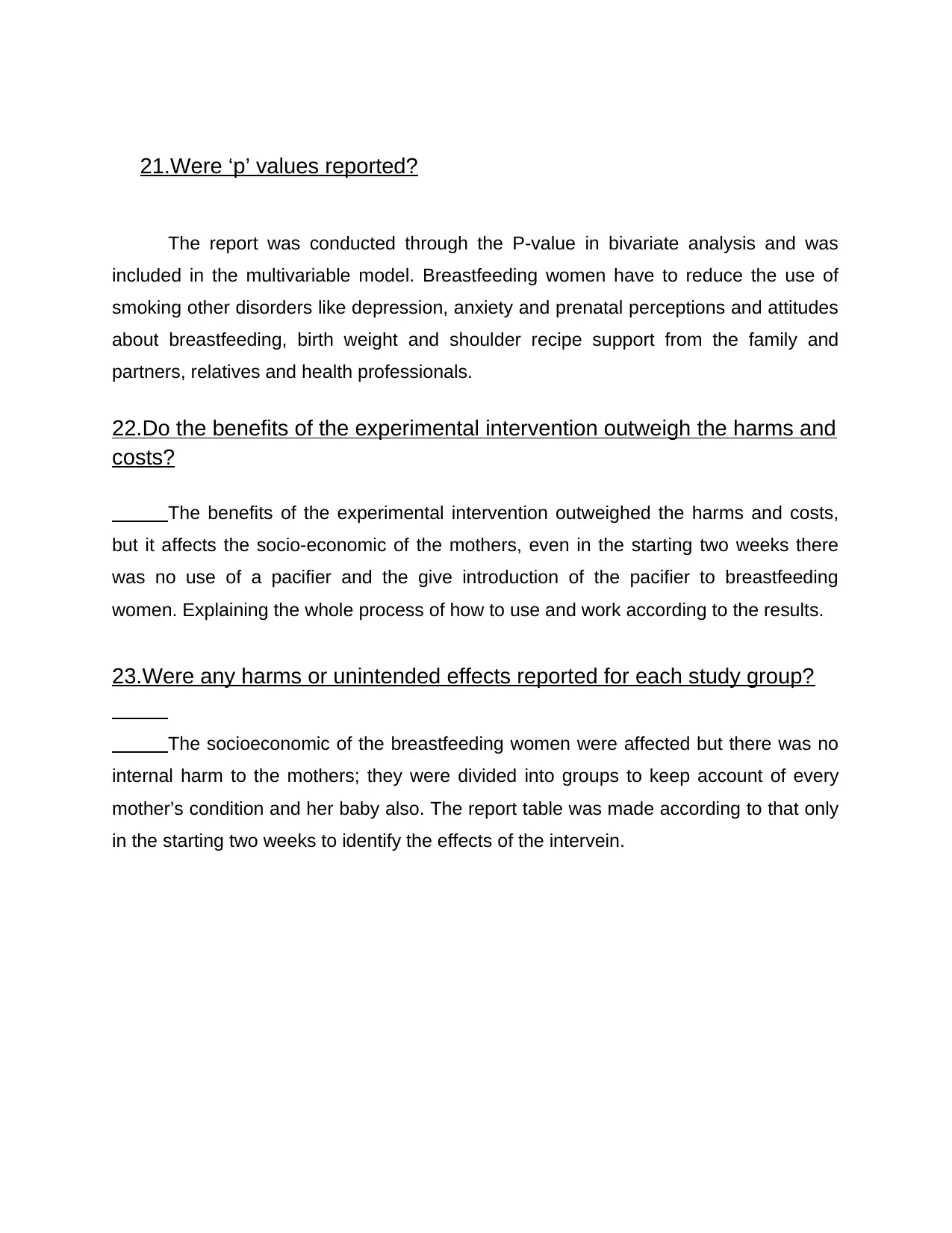
21.Were ‘p’ values reported?
The report was conducted through the P-value in bivariate analysis and was
included in the multivariable model. Breastfeeding women have to reduce the use of
smoking other disorders like depression, anxiety and prenatal perceptions and attitudes
about breastfeeding, birth weight and shoulder recipe support from the family and
partners, relatives and health professionals.
22.Do the benefits of the experimental intervention outweigh the harms and
costs?
The benefits of the experimental intervention outweighed the harms and costs,
but it affects the socio-economic of the mothers, even in the starting two weeks there
was no use of a pacifier and the give introduction of the pacifier to breastfeeding
women. Explaining the whole process of how to use and work according to the results.
23.Were any harms or unintended effects reported for each study group?
The socioeconomic of the breastfeeding women were affected but there was no
internal harm to the mothers; they were divided into groups to keep account of every
mother’s condition and her baby also. The report table was made according to that only
in the starting two weeks to identify the effects of the intervein.
The report was conducted through the P-value in bivariate analysis and was
included in the multivariable model. Breastfeeding women have to reduce the use of
smoking other disorders like depression, anxiety and prenatal perceptions and attitudes
about breastfeeding, birth weight and shoulder recipe support from the family and
partners, relatives and health professionals.
22.Do the benefits of the experimental intervention outweigh the harms and
costs?
The benefits of the experimental intervention outweighed the harms and costs,
but it affects the socio-economic of the mothers, even in the starting two weeks there
was no use of a pacifier and the give introduction of the pacifier to breastfeeding
women. Explaining the whole process of how to use and work according to the results.
23.Were any harms or unintended effects reported for each study group?
The socioeconomic of the breastfeeding women were affected but there was no
internal harm to the mothers; they were divided into groups to keep account of every
mother’s condition and her baby also. The report table was made according to that only
in the starting two weeks to identify the effects of the intervein.
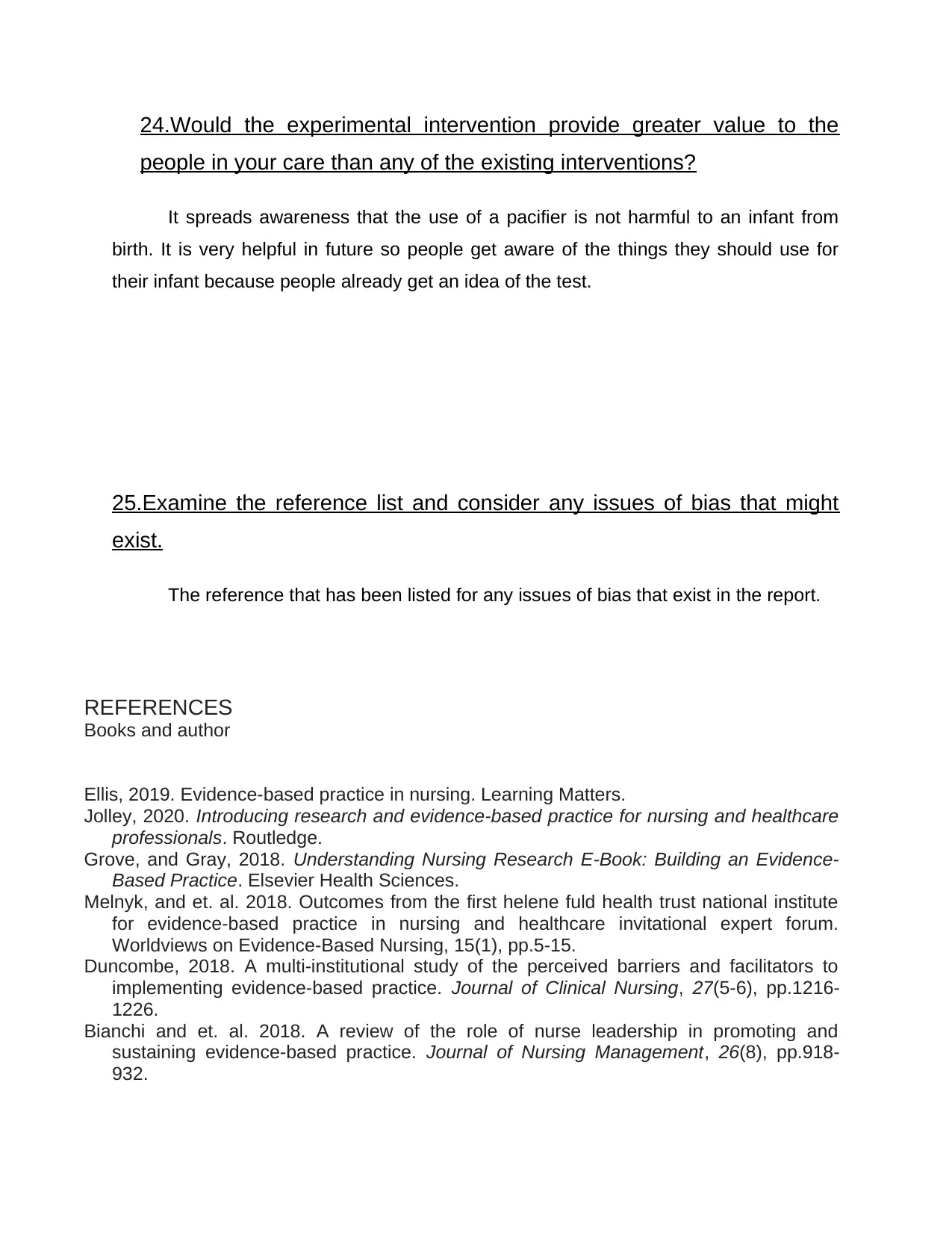
24.Would the experimental intervention provide greater value to the
people in your care than any of the existing interventions?
It spreads awareness that the use of a pacifier is not harmful to an infant from
birth. It is very helpful in future so people get aware of the things they should use for
their infant because people already get an idea of the test.
25.Examine the reference list and consider any issues of bias that might
exist.
The reference that has been listed for any issues of bias that exist in the report.
REFERENCES
Books and author
Ellis, 2019. Evidence-based practice in nursing. Learning Matters.
Jolley, 2020. Introducing research and evidence-based practice for nursing and healthcare
professionals. Routledge.
Grove, and Gray, 2018. Understanding Nursing Research E-Book: Building an Evidence-
Based Practice. Elsevier Health Sciences.
Melnyk, and et. al. 2018. Outcomes from the first helene fuld health trust national institute
for evidence‐based practice in nursing and healthcare invitational expert forum.
Worldviews on Evidence‐Based Nursing, 15(1), pp.5-15.
Duncombe, 2018. A multi‐institutional study of the perceived barriers and facilitators to
implementing evidence‐based practice. Journal of Clinical Nursing, 27(5-6), pp.1216-
1226.
Bianchi and et. al. 2018. A review of the role of nurse leadership in promoting and
sustaining evidence‐based practice. Journal of Nursing Management, 26(8), pp.918-
932.
people in your care than any of the existing interventions?
It spreads awareness that the use of a pacifier is not harmful to an infant from
birth. It is very helpful in future so people get aware of the things they should use for
their infant because people already get an idea of the test.
25.Examine the reference list and consider any issues of bias that might
exist.
The reference that has been listed for any issues of bias that exist in the report.
REFERENCES
Books and author
Ellis, 2019. Evidence-based practice in nursing. Learning Matters.
Jolley, 2020. Introducing research and evidence-based practice for nursing and healthcare
professionals. Routledge.
Grove, and Gray, 2018. Understanding Nursing Research E-Book: Building an Evidence-
Based Practice. Elsevier Health Sciences.
Melnyk, and et. al. 2018. Outcomes from the first helene fuld health trust national institute
for evidence‐based practice in nursing and healthcare invitational expert forum.
Worldviews on Evidence‐Based Nursing, 15(1), pp.5-15.
Duncombe, 2018. A multi‐institutional study of the perceived barriers and facilitators to
implementing evidence‐based practice. Journal of Clinical Nursing, 27(5-6), pp.1216-
1226.
Bianchi and et. al. 2018. A review of the role of nurse leadership in promoting and
sustaining evidence‐based practice. Journal of Nursing Management, 26(8), pp.918-
932.
⊘ This is a preview!⊘
Do you want full access?
Subscribe today to unlock all pages.

Trusted by 1+ million students worldwide
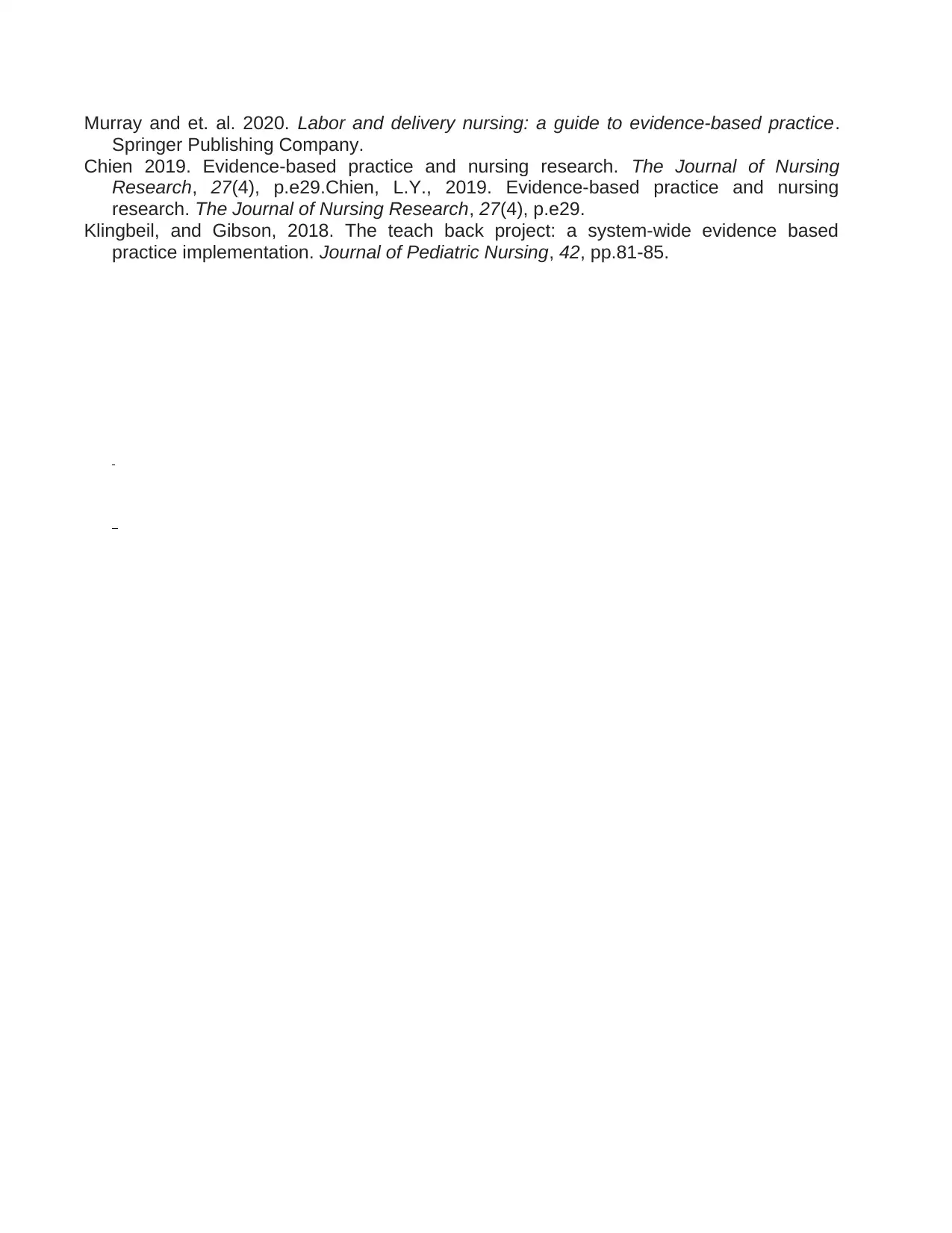
Murray and et. al. 2020. Labor and delivery nursing: a guide to evidence-based practice.
Springer Publishing Company.
Chien 2019. Evidence-based practice and nursing research. The Journal of Nursing
Research, 27(4), p.e29.Chien, L.Y., 2019. Evidence-based practice and nursing
research. The Journal of Nursing Research, 27(4), p.e29.
Klingbeil, and Gibson, 2018. The teach back project: a system-wide evidence based
practice implementation. Journal of Pediatric Nursing, 42, pp.81-85.
Springer Publishing Company.
Chien 2019. Evidence-based practice and nursing research. The Journal of Nursing
Research, 27(4), p.e29.Chien, L.Y., 2019. Evidence-based practice and nursing
research. The Journal of Nursing Research, 27(4), p.e29.
Klingbeil, and Gibson, 2018. The teach back project: a system-wide evidence based
practice implementation. Journal of Pediatric Nursing, 42, pp.81-85.
Paraphrase This Document
Need a fresh take? Get an instant paraphrase of this document with our AI Paraphraser


⊘ This is a preview!⊘
Do you want full access?
Subscribe today to unlock all pages.

Trusted by 1+ million students worldwide
1 out of 13
Related Documents
Your All-in-One AI-Powered Toolkit for Academic Success.
+13062052269
info@desklib.com
Available 24*7 on WhatsApp / Email
![[object Object]](/_next/static/media/star-bottom.7253800d.svg)
Unlock your academic potential
Copyright © 2020–2025 A2Z Services. All Rights Reserved. Developed and managed by ZUCOL.





